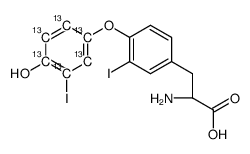3,3'-Diiodo-L-thyronine-13C6
Modify Date: 2025-08-26 19:44:21

3,3'-Diiodo-L-thyronine-13C6 structure
|
Common Name | 3,3'-Diiodo-L-thyronine-13C6 | ||
|---|---|---|---|---|
| CAS Number | 1217459-13-6 | Molecular Weight | 531.03300 | |
| Density | N/A | Boiling Point | N/A | |
| Molecular Formula | C15H13I2NO4 | Melting Point | N/A | |
| MSDS | Chinese USA | Flash Point | N/A | |
| Symbol |

GHS07 |
Signal Word | Warning | |
Use of 3,3'-Diiodo-L-thyronine-13C63,3'-Diiodo-L-thyronine-13C6 is the 13C labeled 3,3'-Diiodo-L-thyronine[1]. 3,3'-Diiodo-L-thyronine (3,3'-T2) is an endogenous metabolite of thyroid hormone. 3,3'-Diiodo-L-thyronine significantly enhances COX activity[2][3]. |
| Name | (2S)-2-amino-3-[4-(4-hydroxy-3-iodophenoxy)-3-iodophenyl]propanoic acid |
|---|---|
| Synonym | More Synonyms |
| Description | 3,3'-Diiodo-L-thyronine-13C6 is the 13C labeled 3,3'-Diiodo-L-thyronine[1]. 3,3'-Diiodo-L-thyronine (3,3'-T2) is an endogenous metabolite of thyroid hormone. 3,3'-Diiodo-L-thyronine significantly enhances COX activity[2][3]. |
|---|---|
| Related Catalog | |
| In Vitro | Stable heavy isotopes of hydrogen, carbon, and other elements have been incorporated into drug molecules, largely as tracers for quantitation during the drug development process. Deuteration has gained attention because of its potential to affect the pharmacokinetic and metabolic profiles of drugs[1]. |
| References |
| Molecular Formula | C15H13I2NO4 |
|---|---|
| Molecular Weight | 531.03300 |
| Exact Mass | 530.91400 |
| PSA | 92.78000 |
| LogP | 4.04840 |
| 3,3 inverted exclamation marka-Diiodo-L-thyronine-(phenoxy-13C6) (T2) |
| T2-13C6 |